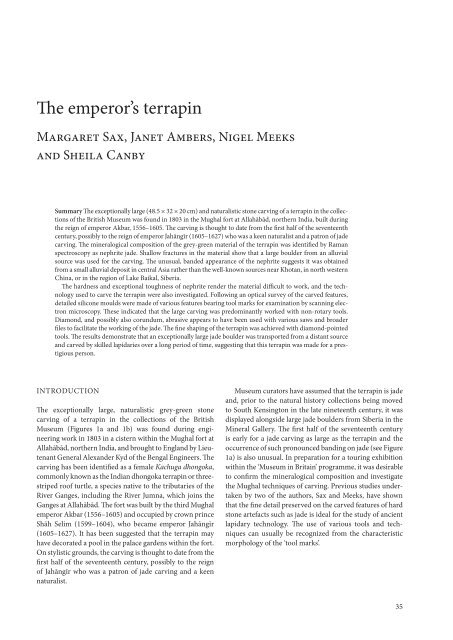The emperor's terrapin - British Museum
The emperor's terrapin - British Museum
The emperor's terrapin - British Museum
You also want an ePaper? Increase the reach of your titles
YUMPU automatically turns print PDFs into web optimized ePapers that Google loves.
Th e emperor’s <strong>terrapin</strong><br />
Margaret Sax, Janet Ambers, Nigel Meeks<br />
and Sheila Canby<br />
Summary Th e exceptionally large (48.5 × 32 × 20 cm) and naturalistic stone carving of a <strong>terrapin</strong> in the collections<br />
of the <strong>British</strong> <strong>Museum</strong> was found in 1803 in the Mughal fort at Allahābād, northern India, built during<br />
the reign of emperor Akbar, 1556–1605. Th e carving is thought to date from the fi rst half of the seventeenth<br />
century, possibly to the reign of emperor Jahāngīr (1605–1627) who was a keen naturalist and a patron of jade<br />
carving. Th e mineralogical composition of the grey-green material of the <strong>terrapin</strong> was identifi ed by Raman<br />
spectroscopy as nephrite jade. Shallow fractures in the material show that a large boulder from an alluvial<br />
source was used for the carving. Th e unusual, banded appearance of the nephrite suggests it was obtained<br />
from a small alluvial deposit in central Asia rather than the well-known sources near Khotan, in north western<br />
China, or in the region of Lake Baikal, Siberia.<br />
Th e hardness and exceptional toughness of nephrite render the material diffi cult to work, and the technology<br />
used to carve the <strong>terrapin</strong> were also investigated. Following an optical survey of the carved features,<br />
detailed silicone moulds were made of various features bearing tool marks for examination by scanning electron<br />
microscopy. Th ese indicated that the large carving was predominantly worked with non-rotary tools.<br />
Diamond, and possibly also corundum, abrasive appears to have been used with various saws and broader<br />
fi les to facilitate the working of the jade. Th e fi ne shaping of the <strong>terrapin</strong> was achieved with diamond-pointed<br />
tools. Th e results demonstrate that an exceptionally large jade boulder was transported from a distant source<br />
and carved by skilled lapidaries over a long period of time, suggesting that this <strong>terrapin</strong> was made for a prestigious<br />
person.<br />
INTRODUCTION<br />
Th e exceptionally large, naturalistic grey-green stone<br />
carving of a <strong>terrapin</strong> in the collections of the <strong>British</strong><br />
<strong>Museum</strong> (Figures 1a and 1b) was found during engineering<br />
work in 1803 in a cistern within the Mughal fort at<br />
Allahābād, northern India, and brought to England by Lieutenant<br />
General Alexander Kyd of the Bengal Engineers. Th e<br />
carving has been identifi ed as a female Kachuga dhongoka,<br />
commonly known as the Indian dhongoka <strong>terrapin</strong> or threestriped<br />
roof turtle, a species native to the tributaries of the<br />
River Ganges, including the River Jumna, which joins the<br />
Ganges at Allahābād. Th e fort was built by the third Mughal<br />
emperor Akbar (1556–1605) and occupied by crown prince<br />
Shāh Selim (1599–1604), who became emperor Jahāngīr<br />
(1605–1627). It has been suggested that the <strong>terrapin</strong> may<br />
have decorated a pool in the palace gardens within the fort.<br />
On stylistic grounds, the carving is thought to date from the<br />
fi rst half of the seventeenth century, possibly to the reign<br />
of Jahāngīr who was a patron of jade carving and a keen<br />
naturalist.<br />
<strong>Museum</strong> curators have assumed that the <strong>terrapin</strong> is jade<br />
and, prior to the natural history collections being moved<br />
to South Kensington in the late nineteenth century, it was<br />
displayed alongside large jade boulders from Siberia in the<br />
Mineral Gallery. Th e fi rst half of the seventeenth century<br />
is early for a jade carving as large as the <strong>terrapin</strong> and the<br />
occurrence of such pronounced banding on jade (see Figure<br />
1a) is also unusual. In preparation for a touring exhibition<br />
within the ‘<strong>Museum</strong> in Britain’ programme, it was desirable<br />
to confi rm the mineralogical composition and investigate<br />
the Mughal techniques of carving. Previous studies undertaken<br />
by two of the authors, Sax and Meeks, have shown<br />
that the fi ne detail preserved on the carved features of hard<br />
stone artefacts such as jade is ideal for the study of ancient<br />
lapidary technology. Th e use of various tools and techniques<br />
can usually be recognized from the characteristic<br />
morphology of the ‘tool marks’.<br />
35
















